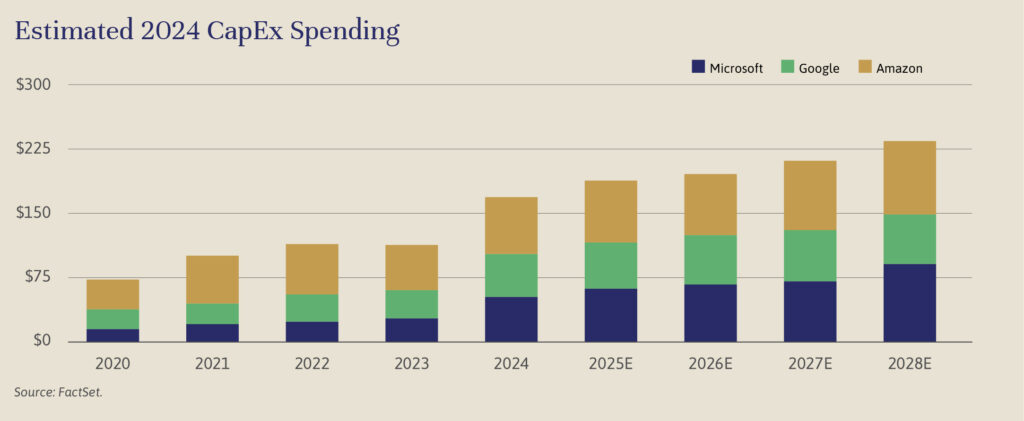
Independent Thinking®
CapEx: Too Much of a Good Thing?
September 30, 2024

Public and private capital expenditure, or CapEx, is at record highs in the United States. From semiconductor manufacturing to cloud infrastructure expansion, to boosting the energy grid, incorporating Artificial Intelligence, or AI, into our lives isn’t cheap. At the same time, companies are also re/onshoring manufacturing, to control more aspects of critical supply chains and convert to greener energy. As the costs total up, thoughtful investors need to reconcile the benefits and the risks.
The scale of the investment is enormous. The largest cloud service providers – Amazon, Microsoft and Google parent Alphabet – are committed to over $150 billion combined in estimated CapEx spending this year.1 The lion’s share is earmarked for AI adoption, including infrastructure, services and research – to drive ever greater computation at ever greater speeds and scale. As illustrated by the chart below, that’s up almost 50% from collective CapEx spending by these three companies last year, and up over 85% from their five-year average.
In addition to these hyperscalers, next-tier cloud providers such as Oracle and IBM are ramping up their own CapEx to support internal AI programs. Indeed, Oracle is projected to double its CapEx in the year ahead. And Meta and Tesla have similarly massive spending requirements for their own networks, projecting $50 billion and $10 billion in CapEx over the next 12 months, respectively. Next up should be spending by corporations in the broader economy, including in the energy, healthcare, consumer products and financial services sectors, which will require the software, data centers and services that the hyperscalers are building out. In addition, plenty of money will be spent on the delivery of AI to people – the so-called Edge AI, which brings the tools to people’s phones and computers – and the energy necessary to enable all of this.
At the base of this investment is a reliance on access to the semiconductors that power all the data processing and analysis underlying AI. U.S. vulnerabilities here were cast into stark relief by the pandemic and cooling ties with China: The CHIPS and Science Act of 2022 has so far sparked announcements from Micron ($25 billion in Idaho), Taiwan Semiconductor ($65 billion in Arizona), Intel ($96 billion between Arizona, Ohio and Oregon), and Samsung ($45 billion in Texas), among others. All told, 80 or so projects are in the works. It is worth noting that these investments should create significant construction jobs and eventually tens of thousands of high-paying technology jobs, as well as make the United States more self-reliant.
More broadly, onshore manufacturing has fiscal support from the Infrastructure Investment and Jobs Act of 2021 and the Inflation Reduction Act of 2022. But bringing manufacturing back to our shores, which had been moved to China or Mexico over the proceeding decades, will not be a simple or immediate task. Still, 70% of U.S.-based companies with a global footprint have expressed an intent to reshore at least a portion of their manufacturing (per Cornerstone Macro) – and many have indeed begun to do so. This trend is being led by companies involved in manufacturing electrical equipment, appliances and components; computer and electronic products; chemicals; transportation equipment; and medical equipment and supplies.2 CapEx spending here outside technology remains low, but that could change soon.

As for the energy grid, the United States has a deservedly terrible reputation. The demand for capital investment is only more pressing now, as the data centers that power AI are using tremendous amounts of energy. The incremental electricity consumption projected from 2024 to 2030 will be the equivalent of three times that of New York City.3 And re/onshoring manufacturing, as well as increasing electric vehicle usage, will only add to domestic energy consumption. Much of this cost will be borne by government-led initiatives, of course. But the private sector is contributing as well, in the power grid, in transmission and distribution, in pipelines, and on alternative energy sources, including natural gas, nuclear and renewables. Utilities across the country are looking to seize the opportunity to address an uptick in energy demand by targeting high-return investments in expanded capacity. At the same time, supporting the grid is an area of some bipartisan support, with proposed legislation released this past July.4
So, what is the risk of overspending and overbuilding? Will the payback on spending be high enough for the hyperscalers and the other big investors to earn an appropriate return on their considerable capital? In the interim, will the profits generated from AI among the end-users – the smaller companies actually deploying AI in their business practices – meet stock market analysts’ currently high expectations? At this rate, we’ll need to see a major shift in productivity and growth over the next decade or so to justify this spend. And to top it off, high PE multiples and the significant concentration in the S&P 500 index to the hyperscalers leading this investment gives us cause for concern.5
Profits are already showing up at the cloud service providers: Microsoft and IBM have both detailed a direct line to revenues from their massive capital spending, as they have been able to convince many of their customers to spend more on AI-enhanced products. Longer term, this cycle has one big advantage over past debt-fueled CapEx booms. The biggest spenders are the biggest and best capitalized companies in the world, with massive research and customer bases. They are primarily using operating cash flow, not debt, to fund AI-driven spending. They should have time to make sure that their investments pay off.
It is unclear yet whether AI-related productivity enhancements will be worth the cost for the average small- or medium-size company. Call centers, pricing algorithms, supply chain and inventory management, and improved customer interactions are among the many use cases posited, but all need time to be implemented before rates of return on investment become clear. Bigger picture, the prospect of autonomous vehicles, AI-enhanced robotics, new and faster research and development in healthcare, energy, space travel and more could have a massive impact on productivity.
As for dependencies, it’s difficult to argue that a more efficient power grid, a shift to greener energy and, eventually, shorter supply lines aren’t in our broader long-term economic interest anyway. This infrastructure needs to be built, regardless of the AI cycle, and a strong CapEx cycle generally bodes well for the economy. To date within energy infrastructure, we do not see signs of overbuilding or bubble economics. Indeed, the question here is whether the developments in these areas will proceed fast enough to support advances in technology. This is an important consideration as the AI investment cycle unfolds unpredictably in parallel.
We continue to believe that overall portfolio diversification, with exposure to cash, defensive and credit-sensitive fixed income, stocks and illiquid alternative investments, if appropriate, is the best risk mitigator. We are always mindful of having too much exposure to any single trend or investment thesis, regardless of the surrounding hype.
Brian Pollak and Michael Kirkbride are Partners and Portfolio Managers at Evercore Wealth Management. They can be contacted at, respectively, [email protected] and [email protected].
1 Per FactSet estimates for 2024 CapEx: AMZN $66bn, MSFT $52.3bn, GOOG $49.8bn (Total $168.1bn)
2 https://sloanreview.mit.edu/article/a-reshoring-renaissance-is-underway/
3 The Electric Butterfly Effect, 6/30/2024, Bernstein Societe Generale Group
4 Energy Permitting Reform Act of 2024 (Manchin, Barrasso)
5 Top 6 = 29.6% of S&P 500 Apple (6.8%), NVDA (6.2%), MSFT (6.8%), GOOG (3.8%) AMZN (3.6%), META (2.4%). As of September 26, 2024
